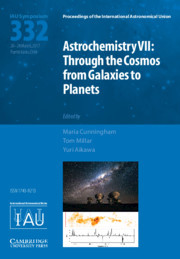Astrochemistry VII (IAU S332) Through the Cosmos from Galaxies to Planets Proceedings of the International Astronomical Union Symposia and Colloquia Series
Langue : Anglais
Coordonnateurs : Cunningham Maria, Millar Tom, Aikawa Yuri

Reviews how observations of organic molecules in space, numerical models and laboratory studies are used to study the Universe's evolution.
The study of astrochemistry has become an important branch of modern astronomy and astrophysics. Molecules are key tools in exploring topics such as star and planet formation, the origin and evolution of interstellar dust grains, the structure of the interstellar medium in galaxies, and the origin of protogalaxies in the early Universe. This volume contains review papers alongside the latest results in the fast-growing discipline of astrochemistry, bringing together contributions from observers, modellers and laboratory astrochemists. It reports results from new observational facilities, such as the Herschel Space Observatory, ALMA, NOEMA, Rosetta and SOFIA, which are leading to new research areas such as the habitability of exoplanets, the origin of prebiotic chemistry and astrobiology. Interleaved with these observation results is the recent, ground-breaking work of physical chemists and numerical modellers, which provides the fundamental theoretical descriptions required to explain the molecular Universe.
Opening address; 1. Atoms and molecules at high redshifts; 2. Ultra-luminous extragalactic chemistry; 3. Observations of a hot molecular core in a low metallicity dwarf galaxy; 4. The ALMA view of UV-irradiated molecular cloud edges; 5. High-temperature chemistry in external galaxies; 6. Low metallicity ISM: physical properties of the gas and dust; 7. Fire from Ice – massive star birth from infrared dark clouds; 8. Tracing the evolution of massive protostars; 9. Chemical change in the disk forming region of IRAS 16293-2422 studied with ALMA; 10. A molecular outflow-prestellar core interaction in L1689N; 11. The excitation and emission spectrum of the hydrogen molecular ion; 12. The molecular inventory of diffuse clouds; 13. Barnard 1b; 14. Astrochemistry of light hydrides with SOFIA; 15. Theoretical approaches to surface chemistry; 16. Molecule and dust formation in late-type stars; 17. Dust formation at cryogenic temperatures; 18. Simulations of branched carbon-chain chemistry in star-forming regions; 19. The photochemical evolution of the interstellar PAH family; 20. Laboratory astrochemistry; 21. Exploring molecular complexity in the Galactic Center with ALMA; 22. Imaging the water snowline in protostellar envelopes; 23. Chemical tracers of dynamics in low-mass protostellar objects; 24. Protostellar Interferometric Line Survey (PILS); 25. Herschel observations of molecular emission lines in low- and intermediate-mass evolved stars; 26. Interstellar reaction screening via microwave spectral taxonomy; 27. Isotopic fractionation in interstellar molecules; 28. Insights into astrochemistry – highlights from the Rosetta mission; 29. On the origin of O2, N2, and other volatile species in comets; 30. ALMA observations of Titan's atmospheric chemistry and seasonal variation; 31. The chemical connection between 67P/C-G and IRAS16293; 32. Nitrogen fractionation in star-forming regions and primitive Solar System materials; 33. Spatially resolved organic chemistry in protoplanetary disks; 34. Unveiling the mid-plane temperature and mass distribution in the giant-planet formation zone; 35. Zooming in on the physics and chemistry of protoplanetary disks with ALMA; 36. Different dust and gas radial extents in protoplanetary disks; 37. ALMA detection of gas-phase methanol in a planet-forming disk; 38. Measuring gas masses and carbon depletion in young disks; 39. Dust in transition disks; 40. Nitrogen fractionation in protoplanetary disks from the H13CN/HC15N ratio; 41. Models of nitrogen isotope fractionation in protoplanetary disks; 42. Chemistry and evolution of the oldest white dwarf planetary systems; 43. What does the chemical composition of giant planets tells us about their formation?; 44. Chemical characterization of exoplanetary atmospheres; 45. JWST: the role of observing facilities in setting the agenda; 46. ALMA Band 1 and astrochemistry; 47. ALMA; 48. Processing of interstellar ices by soft X-rays and swift ions; 49. Laboratory measurements of methanol photolysis branching ratios to guide astrochemical models; 50. Acetaldehyde and carbonaceous dust; 51. Photodestruction of astrophysically relevant ice species; 52. Synchrotron X-ray irradiation of N-rich organics; 53. Gas phase studies of astrochemical importance; 54. Photochemistry and radiation chemistry of cosmic ice analogs of ammonia.
Date de parution : 10-2018
Ouvrage de 462 p.
17.9x25.5 cm
Disponible chez l'éditeur (délai d'approvisionnement : 14 jours).
Prix indicatif 128,95 €
Ajouter au panierThème d’Astrochemistry VII (IAU S332) :
© 2024 LAVOISIER S.A.S.



